Aging Characteristics of Stationary Lithium-Ion Battery Systems with Serial and Parallel Cell Configurations
Abstract
:1. Introduction
2. Experimental Methodology
2.1. Cell Level
2.2. Battery Level
2.3. Microgrid Level
3. Results
3.1. Initial Cell Characterization and Selection
3.2. Microgrid Operation
3.3. Comparison between Periodic Checkups
3.4. Comparison between Initial and Final Checkups
3.5. Comparison to Single-Cell Cycling
4. Discussion
5. Conclusions
- All cells show significant and continuous capacity loss. The average capacity loss after 2.5 years of battery operation was 18.6% and 21.4% for cells in the serial and parallel configuration, respectively. At the same time, the cells showed a decrease of internal resistance.
- A single cell operated with continuous full cycles showed significantly less (a factor of two) capacity loss than the cells in the system. The difference is probably caused by the higher temperature of the cells in the system, compared to the cells in the climate chamber. Therefore, improving thermal management at battery level (e.g., by integrating active cooling strategies) can probably significantly improve cell lifetime.
- The difference in aging between the serial and parallel battery architectures is only small and likely due to the higher and presumably more inhomogeneously distributed cell temperatures in the system with parallel architecture. Higher temperatures may result from higher ohmic losses in the current-collection rails due to significantly higher currents as compared to the serial architecture.
Author Contributions
Funding
Acknowledgments
Conflicts of Interest
References
- Ziegler, M.S.; Trancik, J.E. Re-examining rates of lithium-ion battery technology improvement and cost decline. Energy Environ. Sci. 2021, 14, 1635–1651. [Google Scholar] [CrossRef]
- Figgener, J.; Stenzel, P.; Kairies, K.-P.; Linßen, J.; Haberschusz, D.; Wessels, O.; Angenendt, G.; Robinius, M.; Stolten, D.; Sauer, D.U. The development of stationary battery storage systems in Germany—A market review. J. Energy Storage 2020, 29, 101153. [Google Scholar] [CrossRef]
- Stenzel, P.; Kotzur, L.; Stolten, D.; Figgener, J.; Haberschusz, D.; Sauer, D.U.; Gottke, V.; Valentin, F.; Velten, A.; Schäfer, F.; et al. Energiespeicher. BWK-Das Energ.-Fachmag. 2021, 73, 20–34. [Google Scholar]
- Haas, R.; Kemfert, C.; Auer, H.; Ajanovic, A.; Sayer, M.; Hiesl, A. On the economics of storage for electricity: Current state and future market design prospects. WIREs Energy Environ. 2022, e431. [Google Scholar] [CrossRef]
- Kebede, A.A.; Kalogiannis, T.; van Mierlo, J.; Berecibar, M. A comprehensive review of stationary energy storage devices for large scale renewable energy sources grid integration. Renew. Sustain. Energy Rev. 2022, 159, 112213. [Google Scholar] [CrossRef]
- Berecibar, M.; Garmendia, M.; Gandiaga, I.; Crego, J.; Villarreal, I. State of health estimation algorithm of LiFePO4 battery packs based on differential voltage curves for battery management system application. Energy 2016, 103, 784–796. [Google Scholar] [CrossRef]
- Mingant, R.; Bernard, J.; Sauvant-Moynot, V. Novel state-of-health diagnostic method for Li-ion battery in service. Appl. Energy 2016, 183, 390–398. [Google Scholar] [CrossRef] [Green Version]
- Schuster, S.F.; Brand, M.J.; Berg, P.; Gleissenberger, M.; Jossen, A. Lithium-ion cell-to-cell variation during battery electric vehicle operation. J. Power Source 2015, 297, 242–251. [Google Scholar] [CrossRef]
- Ecker, M.; Nieto, N.; Käbitz, S.; Schmalstieg, J.; Blanke, H.; Warnecke, A.; Sauer, D.U. Calendar and cycle life study of Li(NiMnCo)O2 -based 18650 lithium-ion batteries. J. Power Source 2014, 248, 839–851. [Google Scholar] [CrossRef]
- Omar, N.; Monem, M.A.; Firouz, Y.; Salminen, J.; Smekens, J.; Hegazy, O.; Gaulous, H.; Mulder, G.; Van den Bossche, P.; Coosemans, T.; et al. Lithium iron phosphate based battery—Assessment of the aging parameters and development of cycle life model. Appl. Energy 2014, 113, 1575–1585. [Google Scholar] [CrossRef]
- Sarasketa-Zabala, E.; Gandiaga, I.; Rodriguez-Martinez, L.M.; Villarreal, I. Calendar ageing analysis of a LiFePO4/graphite cell with dynamic model validations: Towards realistic lifetime predictions. J. Power Source 2014, 272, 45–57. [Google Scholar] [CrossRef]
- Wang, J.; Liu, P.; Hicks-Garner, J.; Sherman, E.; Soukiazian, S.; Verbrugge, M.; Tataria, H.; Musser, J.; Finamore, P. Cycle-life model for graphite-LiFePO4 cells. J. Power Source 2011, 196, 3942–3948. [Google Scholar] [CrossRef]
- Fu, R.; Choe, S.-Y.; Agubra, V.; Fergus, J. Development of a physics-based degradation model for lithium ion polymer batteries considering side reactions. J. Power Source 2015, 278, 506–521. [Google Scholar] [CrossRef]
- Watanabe, S.; Kinoshita, M.; Nakura, K. Capacity fade of LiNi(1−x−y)CoxAlyO2 cathode for lithium-ion batteries during accelerated calendar and cycle life test. I. Comparison analysis between LiNi(1−x−y)CoxAlyO2 and LiCoO2 cathodes in cylindrical lithium-ion cells during long term storage test. J. Power Source 2014, 247, 412–422. [Google Scholar] [CrossRef]
- Leonardi, S.G.; Aloisio, D.; Brunaccini, G.; Stassi, A.; Ferraro, M.; Antonucci, V.; Sergi, F. Investigation on the ageing mechanism for a lithium-ion cell under accelerated tests: The case of primary frequency regulation service. J. Energy Storage 2021, 41, 102904. [Google Scholar] [CrossRef]
- Abraham, D.P.; Reynolds, E.M.; Sammann, E.; Jansen, A.N.; Dees, D.W. Aging characteristics of high-power lithium-ion cells with LiNi0.8Co0.15Al0.05O2 and Li4/3Ti5/3O4 electrodes. Electrochimica Acta 2005, 51, 502–510. [Google Scholar] [CrossRef]
- Palacín, M.R. Understanding ageing in Li-ion batteries: A chemical issue. Chem. Soc. Rev. 2018, 47, 4924–4933. [Google Scholar] [CrossRef]
- Vetter, J.; Novák, P.; Wagner, M.R.; Veit, C.; Möller, K.-C.; Besenhard, J.O.; Winter, M.; Wohlfahrt-Mehrens, M.; Vogler, C.; Hammouche, A. Ageing mechanisms in lithium-ion batteries. J. Power Source 2005, 147, 269–281. [Google Scholar] [CrossRef]
- Alipour, M.; Ziebert, C.; Conte, F.V.; Kizilel, R. A Review on Temperature-Dependent Electrochemical Properties, Aging, and Performance of Lithium-Ion Cells. Batteries 2020, 6, 35. [Google Scholar] [CrossRef]
- Kupper, C.; Weißhar, B.; Rißmann, S.; Bessler, W.G. End-of-Life Prediction of a Lithium-Ion Battery Cell Based on Mechanistic Aging Models of the Graphite Electrode. J. Electrochem. Soc. 2018, 165, A3468–A3480. [Google Scholar] [CrossRef]
- Carelli, S.; Bessler, W.G. Prediction of reversible lithium plating with a pseudo-3D lithium-ion battery model. J. Electrochem. Soc. 2020, 167, 100515. [Google Scholar] [CrossRef]
- Reniers, J.M.; Mulder, G.; Howey, D.A. Review and Performance Comparison of Mechanical-Chemical Degradation Models for Lithium-Ion Batteries. J. Electrochem. Soc. 2019, 166, A3189–A3200. [Google Scholar] [CrossRef] [Green Version]
- Zhang, W.-J. Structure and performance of LiFePO4 cathode materials: A review. J. Power Source 2011, 196, 2962–2970. [Google Scholar] [CrossRef]
- Li, Z.; Zhang, D.; Yang, F. Developments of lithium-ion batteries and challenges of LiFePO4 as one promising cathode material. J. Mater. Sci. 2009, 44, 2435–2443. [Google Scholar] [CrossRef]
- Yagci, M.C.; Behmann, R.; Daubert, V.; Braun, J.A.; Velten, D.; Bessler, W.G. Electrical and Structural Characterization of Large-Format Lithium Iron Phosphate Cells Used in Home-Storage Systems. Energy Technol. 2021, 9, 2000911. [Google Scholar] [CrossRef]
- Dreyer, W.; Jamnik, J.; Guhlke, C.; Huth, R.; Moškon, J.; Gaberšček, M. The thermodynamic origin of hysteresis in insertion batteries. Nat. Mater. 2010, 9, 448–453. [Google Scholar] [CrossRef] [PubMed]
- Dongol, D.; Feldmann, T.; Schmidt, M.; Bollin, E. A MPC Based Peak Shaving Application for a Household with Photovoltaic Battery System. In Smart Cities, Green Technologies and Intelligent Transport Systems, Proceedings of the SMARTGREENS 2018, VEHITS 2018 Communications in Computer and Information Science, Funchal, Madeira, Portugal, 16–18 March 2019; Springer: Berlin/Heidelberg, Germany, 2019; Volume 992, pp. 44–66. [Google Scholar] [CrossRef]
- Dongol, D.; Feldmann, T.; Bollin, E. An Overview to the concept of Smart Coupling and Battery Management for Grid connected Photovoltaic System. J. Electron. Sci. Technol. 2015, 13, 367–372. [Google Scholar] [CrossRef]
- Dongol, D.; Feldmann, T.; Schmidt, M.; Bollin, E. A model predictive control based peak shaving application of battery for a household with photovoltaic system in a rural distribution grid. Sustain. Energy Grids Netw. 2018, 16, 1–13. [Google Scholar] [CrossRef]
- Weißhar, B.; Bessler, W.G. Model-based lifetime prediction of an LFP/graphite lithium-ion battery in a stationary photovoltaic battery system. J. Energy Storage 2017, 14, 179–191. [Google Scholar] [CrossRef]
- Uddin, K.; Moore, A.D.; Barai, A.; Marco, J. The effects of high frequency current ripple on electric vehicle battery performance. Appl. Energy 2016, 178, 142–154. [Google Scholar] [CrossRef] [Green Version]
- Korth Pereira Ferraz, P.; Kowal, J. A Comparative Study on the Influence of DC/DC-Converter Induced High Frequency Current Ripple on Lithium-Ion Batteries. Sustainability 2019, 11, 6050. [Google Scholar] [CrossRef] [Green Version]
- De Breucker, S.; Engelen, K.; D’hulst, R.; Driesen, J. Impact of current ripple on Li-ion battery ageing. World Electr. Veh. J. 2013, 6, 532–540. [Google Scholar] [CrossRef] [Green Version]
- Beh, H.Z.Z.; Covic, G.A.; Boys, J.T. Effects of pulse and DC charging on lithium iron phosphate (LiFePO4) batteries. In Proceedings of the 2013 IEEE Energy Conversion Congress and Exposition, Denver, CO, USA, 15–19 September 2013; pp. 315–320. [Google Scholar] [CrossRef]
- Bessman, A.; Soares, R.; Wallmark, O.; Svens, P.; Lindbergh, G. Aging effects of AC harmonics on lithium-ion cells. J. Energy Storage 2019, 21, 741–749. [Google Scholar] [CrossRef]
- Steinstraeter, M.; Gandlgruber, J.; Everken, J.; Lienkamp, M. Influence of pulse width modulated auxiliary consumers on battery aging in electric vehicles. J. Energy Storage 2022, 48, 104009. [Google Scholar] [CrossRef]
- Safari, M.; Delacourt, C. Aging of a Commercial Graphite/LiFePO4 Cell. J. Electrochem. Soc. 2011, 158, A1123. [Google Scholar] [CrossRef]
- Grolleau, S.; Delaille, A.; Gualous, H.; Gyan, P.; Revel, R.; Bernard, J.; Redondo-Iglesias, E.; Peter, J. Calendar aging of commercial graphite/LiFePO4 cell—Predicting capacity fade under time dependent storage conditions. J. Power Source 2014, 255, 450–458. [Google Scholar] [CrossRef]
- Naumann, M.; Spingler, F.B.; Jossen, A. Analysis and modeling of cycle aging of a commercial LiFePO4/graphite cell. J. Power Source 2020, 451, 227666. [Google Scholar] [CrossRef]

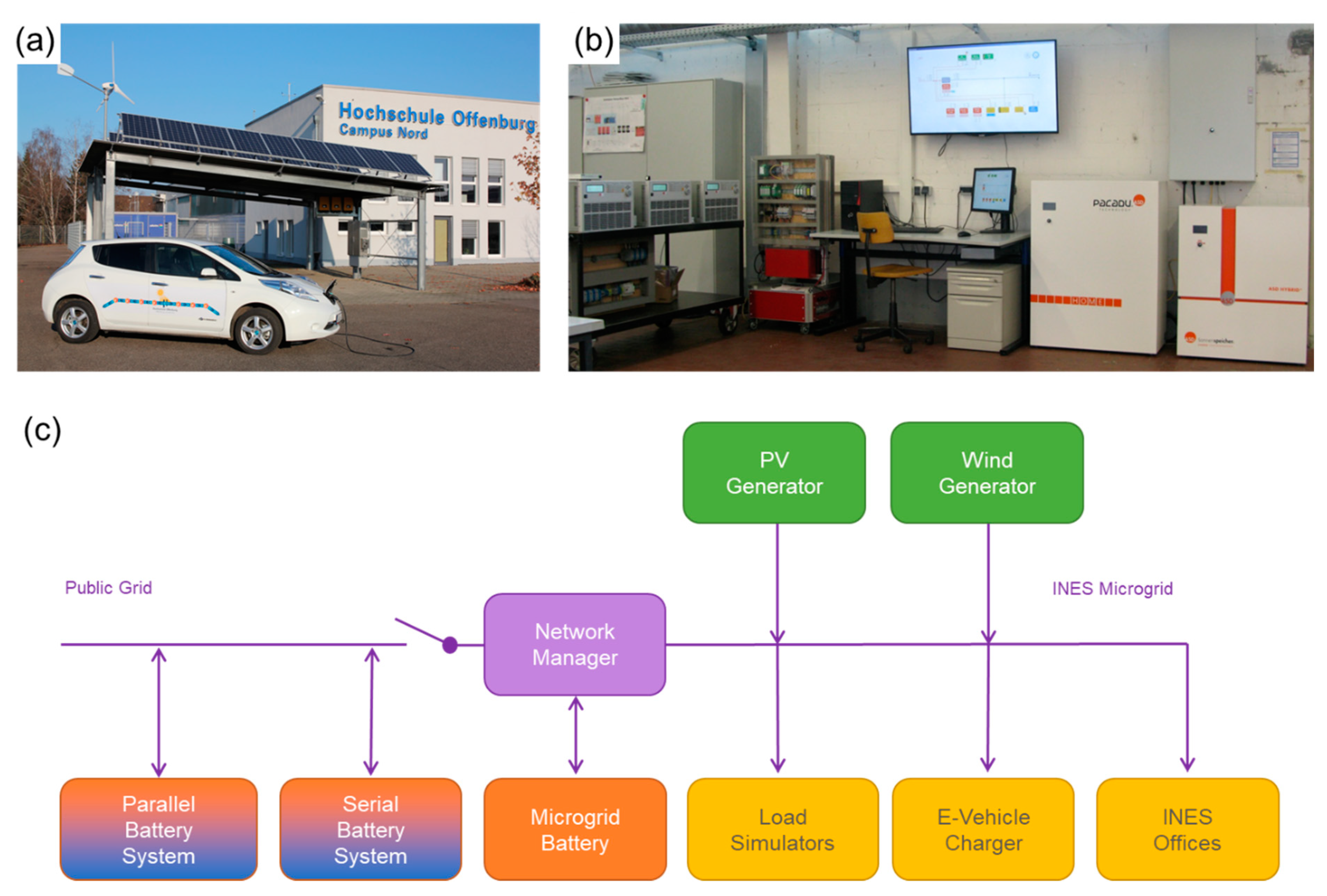
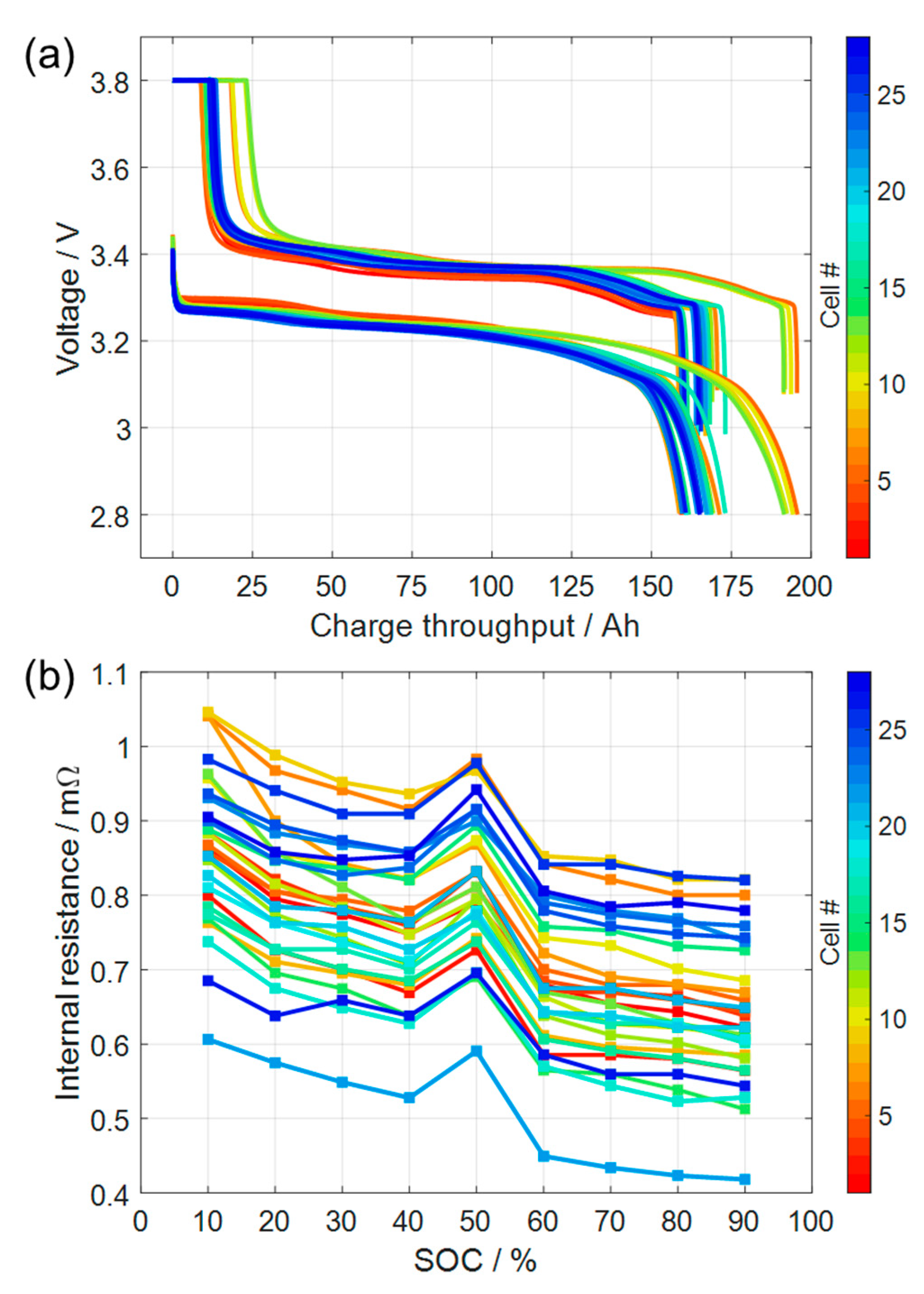
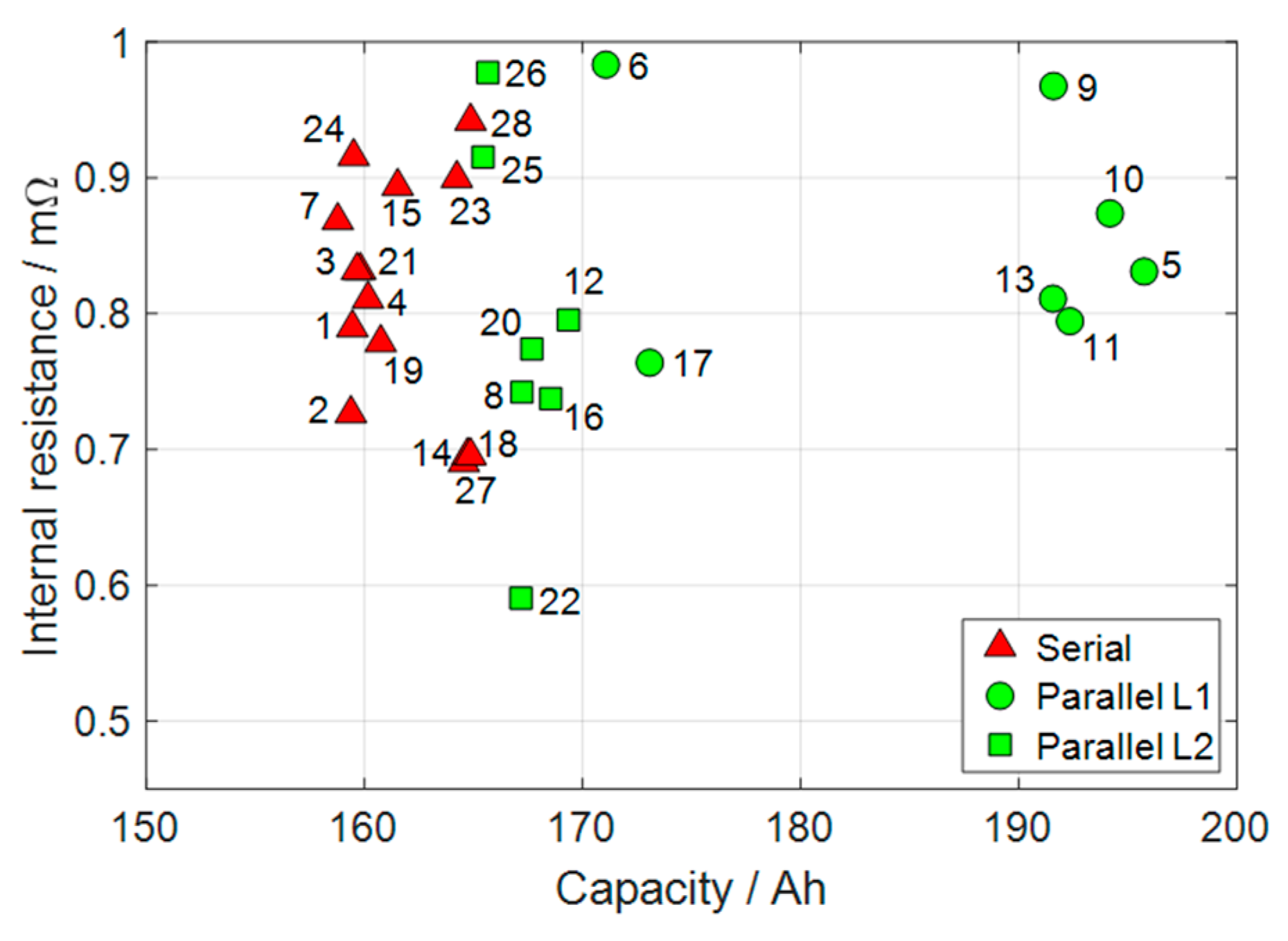


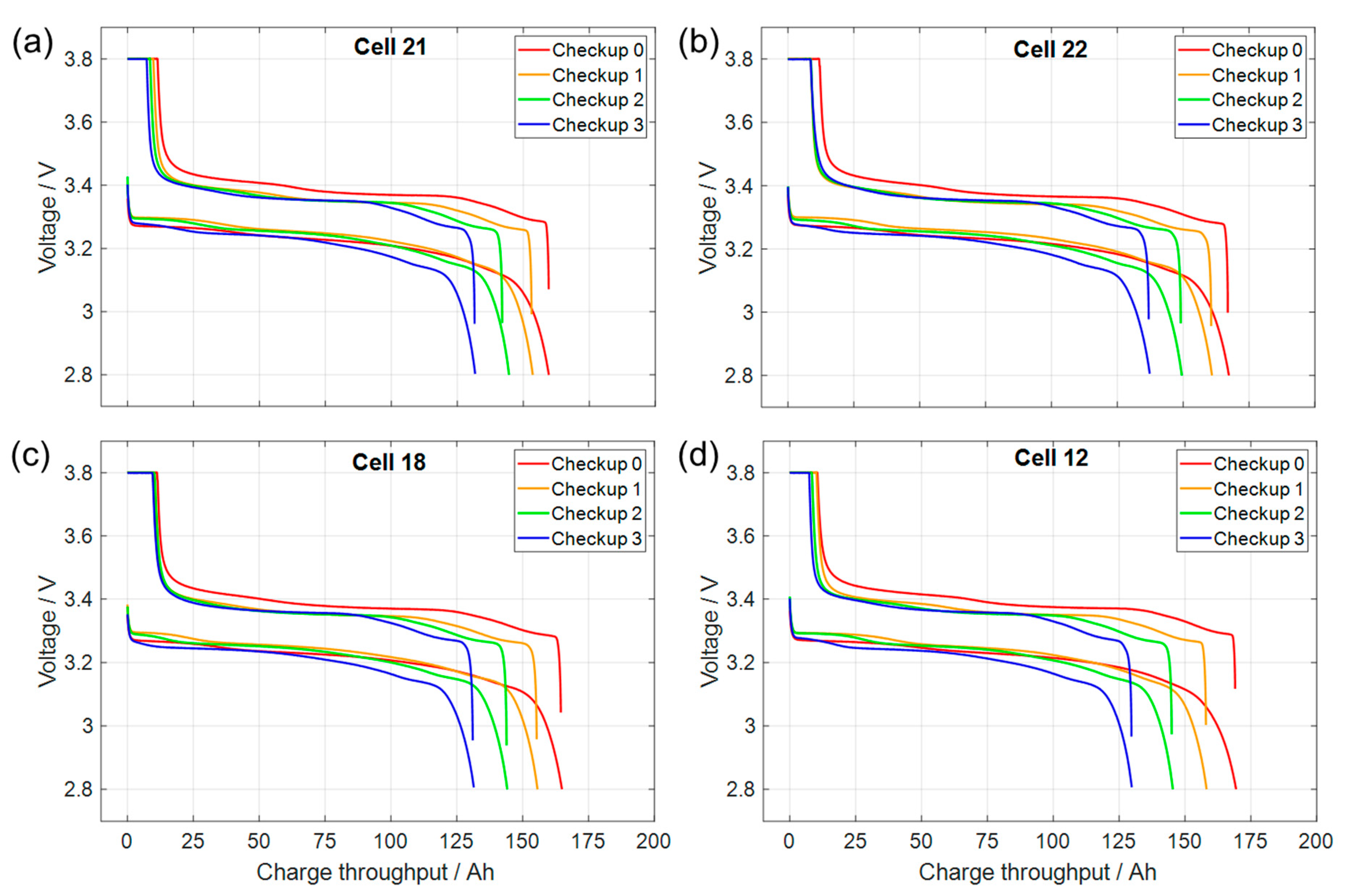

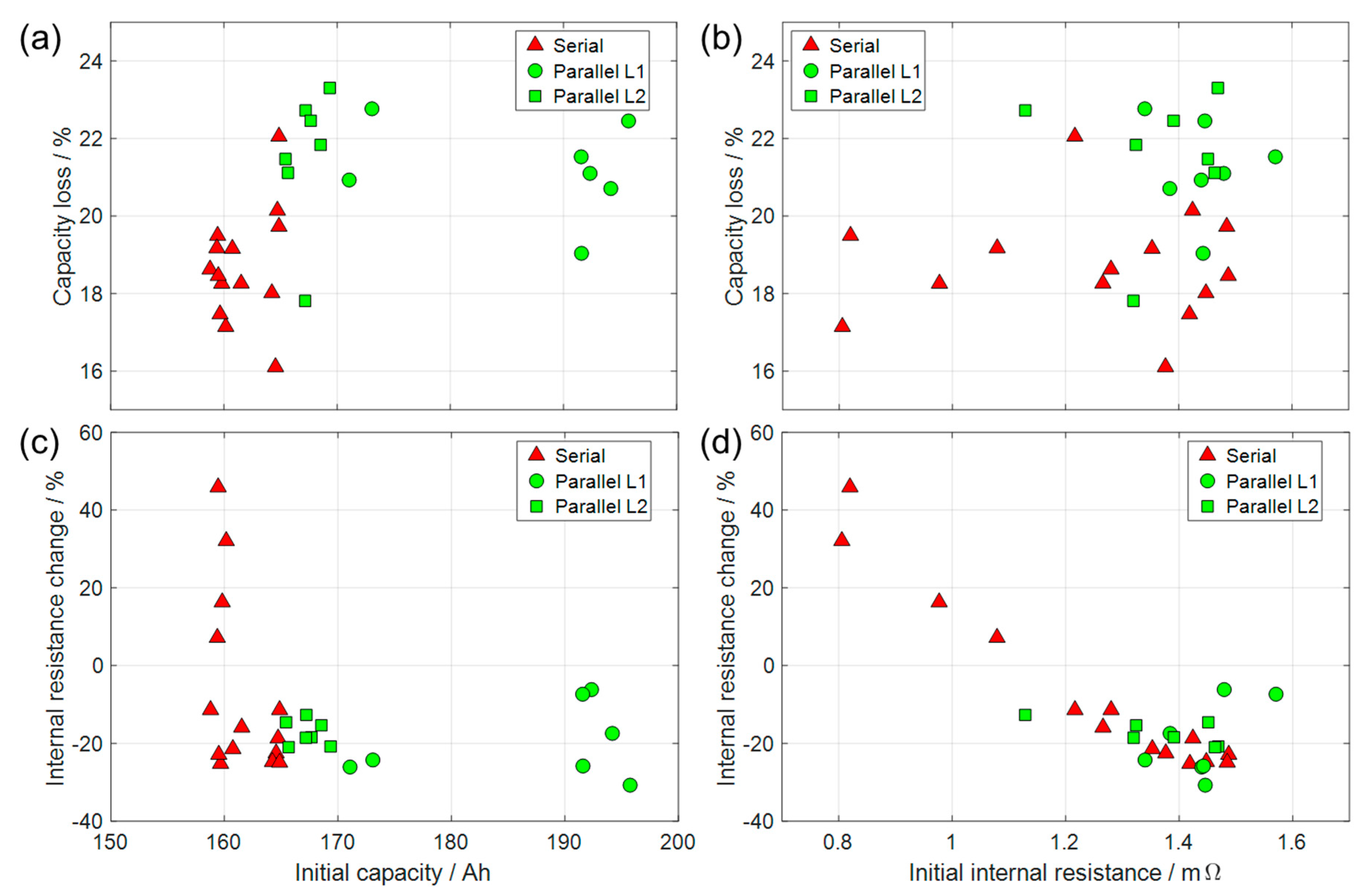


| Serial Cell Configuration | Parallel Cell Configuration | |
|---|---|---|
| Voltage and current | High voltage, low current | Low voltage, high current |
| Advantages | Low ohmic losses, cheaper circuit components | Passive self-balancing, robust towards cell-to-cell variations |
| Disadvantages | Active balancing required, performance prone to single-cell failures | High ohmic losses, high-current components required |
| Capacity | Internal Resistance | |||||
|---|---|---|---|---|---|---|
| Δ/Ah | µ/Ah | σ/Ah | Δ/mΩ | µ/mΩ | σ/mΩ | |
| Serial cell configuration | 6.08 | 161.59 | 2.18 | 0.251 | 0.812 | 0.071 |
| Parallel cell configuration | 30.3 | 177.18 | 11.35 | 0.392 | 0.825 | 0.085 |
| Serial | Parallel | |||||
|---|---|---|---|---|---|---|
| Δ/% | µ/% | σ/% | Δ/% | µ/% | σ/% | |
| Checkup 1 | 2.1 | 4.3 | 0.6 | 3.9 | 5.9 | 1.4 |
| Checkup 2 | 3.1 | 10.9 | 0.9 | 3.7 | 12.7 | 1.2 |
| Checkup 3 | 4.1 | 18.6 | 1.2 | 5.4 | 21.4 | 1.5 |
Publisher’s Note: MDPI stays neutral with regard to jurisdictional claims in published maps and institutional affiliations. |
© 2022 by the authors. Licensee MDPI, Basel, Switzerland. This article is an open access article distributed under the terms and conditions of the Creative Commons Attribution (CC BY) license (https://creativecommons.org/licenses/by/4.0/).
Share and Cite
Yagci, M.C.; Feldmann, T.; Bollin, E.; Schmidt, M.; Bessler, W.G. Aging Characteristics of Stationary Lithium-Ion Battery Systems with Serial and Parallel Cell Configurations. Energies 2022, 15, 3922. https://doi.org/10.3390/en15113922
Yagci MC, Feldmann T, Bollin E, Schmidt M, Bessler WG. Aging Characteristics of Stationary Lithium-Ion Battery Systems with Serial and Parallel Cell Configurations. Energies. 2022; 15(11):3922. https://doi.org/10.3390/en15113922
Chicago/Turabian StyleYagci, Mehmet C., Thomas Feldmann, Elmar Bollin, Michael Schmidt, and Wolfgang G. Bessler. 2022. "Aging Characteristics of Stationary Lithium-Ion Battery Systems with Serial and Parallel Cell Configurations" Energies 15, no. 11: 3922. https://doi.org/10.3390/en15113922
APA StyleYagci, M. C., Feldmann, T., Bollin, E., Schmidt, M., & Bessler, W. G. (2022). Aging Characteristics of Stationary Lithium-Ion Battery Systems with Serial and Parallel Cell Configurations. Energies, 15(11), 3922. https://doi.org/10.3390/en15113922





